By: debbie lynn elias
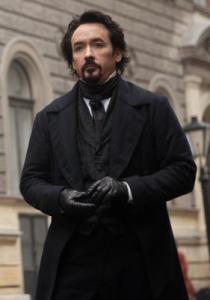
To paraphrase Edgar Allan Poe’s own descriptive terms in The Tell-Tale Heart, what many may mistake for my own madness is but over-acuteness of the senses when it comes to THE RAVEN. In a phrase, A MASTERPIECE! Thanks to an inventive, intriguing and intricately twisting script courtesy of scribes Ben Livingston and Hannah Shakespeare, which is exquisitely showcased and brought to life by director James McTeigue, fact meets fiction during the last days of Poe’s life as he becomes embroiled in a game of cat and mouse with a serial killer replicating the gruesome murders Poe himself has so eloquently crafted for the masses. But the crimes become personal when Poe goes from potential suspect to fighting to save the life of his beloved Emily and stay one step ahead of the killer. Emboldened by an Oscar-worthy performance by John Cusack who, as Poe, is so powerful, so mesmerizing, that there is no trace of Cusack, we see and hear only Poe, THE RAVEN is a masterpiece worthy of the master of macabre himself.
The final days of Edgar Allan Poe are shrouded in mystery even to this day. His death itself, even more mysterious. As for his life, there is much written not only by Poe, but about Poe, including his own analysis and dissection of his own works. Blending elements of each, and taking literary license to posit a fictional murder mystery predicated upon Poe’s own grisly murder stories, we are shockingly welcomed into the world of Edgar Allan Poe when a mother and daughter are found murdered in their three-story walk-up. Appearing as a vicious murder, there is one problem. How did the killer escape? The room was sealed. The police heard the killer behind closed doors, but on gaining entrance, they are met only with bloodied corpses. The windows are locked. There are no other doors. Where did he go? On closer inspection, Detective Emmett Fields finds the answer. A spring lock in the window; a spring lock constructed in the same manner as that described in a fictional story by Edgar Allan Poe. Known for his flamboyant darkness, alcoholism and bouts of melodramatic mania, could Poe be the killer?
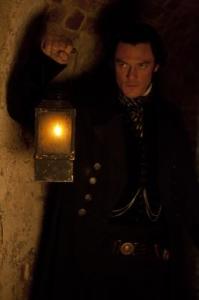
Fields’ suspicions are quickly put to rest, however, as while Poe is being questioned in Field’s office, another murder – identical to another one fictionalized by Poe – is committed. This is taking fandom too far. Wanting to remove himself from the situation, Poe refuses to help Fields solve the crimes, that is until his beloved fiancé Emily is kidnapped by the killer. With clues mounting and the clock ticking, Poe and Fields revisit Poe’s most famous works as they move in for their own kill.
This is the Oscar moment for which John Cusack has worked and waited. He is spellbinding. He IS Edgar Allan Poe. Embodying the fact and fiction of Poe, Cusack brings the very essence of Poe to life in what I believe to be one of the most historically accurate personifications of the man himself. Beyond capturing the physical gauntness and ebony tones of Poe, Cusack’s rhythmic cadence and elocution of the vernacular of the day, and particularly Poe’s lyrical verbiage, is impeccable. The sweeping grandeur of emotion and theatrical melodrama that Cusack brings to each movement and action teeters between madness, alcohol and the genetic dramatic gravitas inherited from Poe’s actor parents, all allowing the audience to decide for themselves – is this madness or is this truth? I have never seen Cusack this powerful, commanding and all consuming. He fills the screen with his presence. Your heart aches with him over Poe’s passion, his loves, and races with his as Poe tries to save his beloved Emily. Not only do we see Poe’s heart on his sleeve, but his pain, frustration and anxiety. Through Cusack’s performance, we “feel” Edgar Allan Poe. It is impossible to tell where Edgar Allan Poe and John Cusack begin and end as this performance is so mesmerizing, it’s as if they are one in the same. Cusack shows us Poe’s darkness, but he also gives us his heart and humor.
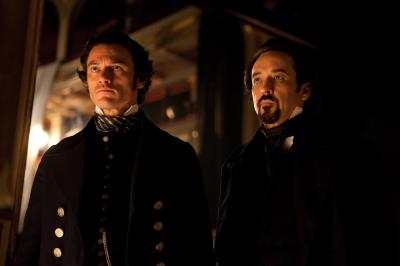
Viewing this role as “a great challenge and opportunity”, in order to achieve this state of dark perfection and the intonations and lyricism of Poe, Cusack immersed himself in all things Poe and “tried to get under the skin of this very very complex genius.” Always humble, Cusack’s first credit goes to the screenwriters. “I think the script was terrific. And then James [McTeigue] and I went through it with the writers and some people and tried to pull as much of Poe’s own dialogue as we could, in his letters and from his novels. So we put that cadence and idiom into the structure of this genre story which is basically kind of a Poe story where Poe becomes a character in one of his own stories. So you have Poe deconstructing Poe, so even though it’s fantasy. . .I was probably a little bit obsessed and drove James crazy trying to say, ‘Yep, Poe said this and he said this.’ I was always trying to use his own vernacular and his own words as much as I could in the fictional setting. . .[and] there’s volumes and volumes of [Poe’s] own thoughts on his writings.”

Then we have Luke Evans. Calm, methodical, proud with even a touch of vanity at times, as Detective Emmett Fields, he is as much a conundrum as Poe, making the two a perfect pairing. And as with Cusack, through the eyes, you see the wheels turning inside, analyzing, rationalizing, conceptualization and aching in frustration at the thought of being defeated or losing another victim. Fascinating character study of both men. And quite notable is Evans’ pitch perfect 19th Century American accent. Nicely played.
Brendan Gleeson is perfect as the retired Navy man turned monied businessman, Captain Charles Hamilton a man who wants to keep his daughter close to him and not share her. Gleeson gives Hamilton such a blustery bravado and sense of protectiveness that at times one wonders if he is the serial killer, going to such lengths to insure his daughter stays away from Poe. And then he just as easily, tacitly eats crow when he realizes his tight rein on Emily could be her death. Very few men could pull of this sense of metaphoric strangulation of a loved one, but Gleeson does.
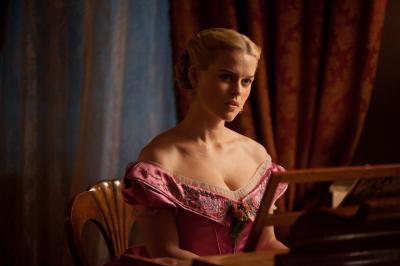
Sadly, the one downfall is Alice Eve and her portrayal of Emily. I never felt or sensed any chemistry between her Emily and Cusack’s Poe; never sensed a daughter’s displeasure with her father’s choke hold; never sensed any urgency of love. Where Eve does sell the character is when confined underground in a wooden coffin. And yes, she was actually placed at times in either a three-sided coffin or fully enveloped four-sided one. But, then just as quickly, she loses me with saying the words “Okay. Okay.” While I know the word became infused into the American vernacular somewhere in the 1830’s and 1840’s, it was still more closely associated with Black slaves than upper class white girls. Its use took me out of the moment each time she said it and then juxtaposed with Poe’s properly articulated verbiage, not to mention that of Fields’, the use by Eve’s Emily just didn’t sit well.
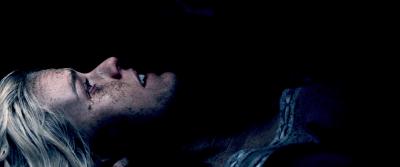
But, let’s talk about the script. Written by Ben Livingston and Hannah Shakespeare, this meld of fact and fiction, predicated upon Poe’s own fiction, is nothing short of brilliant. It’s as if Poe reached his hand from the beyond and put pen to paper. Never was I lulled into ease or comfort. The tension and suspense kept building, intensifying to a heart-pounding crescendo as I felt the race against time right along with Poe and Fields. Interestingly is that slower, more casual dialogue engagements led to more frenzied and reactionary verbiage as the film progressed; which was then aided by the delivery of both Cusack and Evans. The integration of Poe’s own handiwork into the storyline was only complimented and showcased by the visuals that brought the imagination so vividly to life. Look for reference to Annabel Lee, A Descent into the Maelstrom at the Bar, Murders in the Rue Morgue, Premature Burial, The Metamorphosis of Narcissus and Premature Burial. And I have to say, following all the clues and references, while I was convinced the killer was one individual, imagine my surprise and glee to discover whom it really is! Livingston and Shakespeare also go tongue-in-cheek with characters and dialogue (i.e., a character sliced and diced a la The Pit and the Pendulum is named after a critic of Poe’s), adding levels of irony to the gothic macabre.
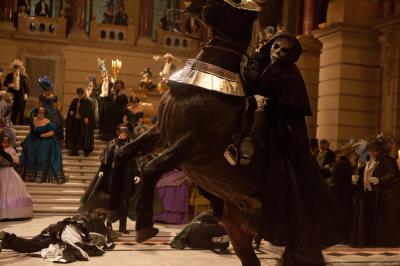
Directed by James McTeigue, THE RAVEN is as technically calculated and precise as one of Poe’s murder mysteries. Shooting on film, THE RAVEN has a timeless quality to it. My jaw was agape for almost the entire film just in awe of the magic on screen. The visuals match the power of Cusack’s performance. Production values are dazzlingly meticulous and impeccably done with a high polish finish right up into and through the credits which have a heart-stopping visual blending and morphing blue moire silk into steely splintered black and red graphics.
Can we please start Oscar nominations for cinematography now? Danny Ruhlman comes out of nowhere and wows us with visuals that are sleek, icy, cold, creative. Between Ruhlman’s framing and angular lensing and Niven Howie’s editing, there are times I felt like I was spiraling out of control like an Escher lithograph. STUNNING! Razor-edged, cold and calculating visuals that mirror the story and legends at hand. And then there is the warmth and balance of intimate candlelit scenes between Poe and Emily, artfully integrated with the ever changing tonal bandwidth of scenes between Poe and Fields which are distanced, wide, cold, black and white, slowly morphing into mid-shots and close-ups with warmer lighting. Using the key elements of lighting and negative space, Ruhlmann’s work is masterful. Believing lighting to be “the most important thing”, he uses the dark, dank, winter weather of Hungary to his advantage. While key lighting focuses on pitting highlights in the characters’ faces against surrounding shadows, negative space is created through framing, focus and shadows to create an unexpected visual area. Keeping the actors’ eyes in tight focus allows the background to then “fall off” the frame while shadows are maintained by carefully designed lighting exposure, creating an emotionally ambient sense of unseen foreboding. For Ruhlmann, this use of negative space engages the audience. “If the audience has to think about what is in the shadows, or what is happening in another part of the frame, it takes them away from their reality and draws them into the story a bit more.”
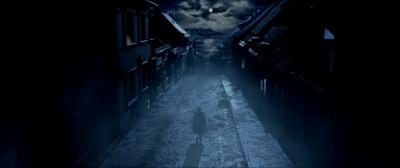
Production Designer Roger Ford has done it again. Exquisitely transportive, one is immersed in the day, right down to the muddy puddles of the cobblestone streets, the dark wood corniches and chair rails, the cavernous underground bricked waterworks. Although the story takes place in 1849 Baltimore, due to the homogenized nature of the US and the Maryland area now, the filmmakers went to Europe and found Budapest and Serbia as the perfect 1849 replica. In fact, for many underground tunnel sequences, they were able to film in the centuries old underground fortification tunnels at a castle in Novi Sad. But then again, the construction of the sets and facades were so immaculate, it is impossible to distinguish the past from the present on screen. The multitude of sets with intricate detail personifying each character to perfection is mind boggling. Cinematographer Ruhlman has nothing but compliments for Ford, describing him as beyond amazing. “He created small side tunnels and spaces within the tunnels that allowed me to put in lights. Toward the end of the tunnel it wouldn’t just disappear, it would go around in an arc, so I could place a small lamp in the background to give us that depth we required that would be enough to silhouette the foreground.”
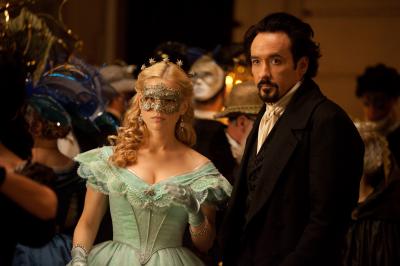
And let’s applaud both Ford and costume designer Carlo Poggioli for the gorgeous ballroom sequence within the film. A dazzling contrast to Poe’s darkness, the costumes and masks are breathtakingly beautiful. So delicate. So light. The expansive claustrophobia that is celebrated with lensing. A feast for the senses. And then to culminate in a climactic scene from The Mask of the Red Death after the tension building editing of a skeletal rider juxtapositioned against the masked ball-goers and the fun and merriment of the gala! When the horse bursts into the room, and Fields’ gun goes off, there is a brilliant shot of bright red blood on the rider set against the pastels and subdued golden tones of the ball – well, my heart stopped from the meticulous beauty of the scene.
Of course, I would be remiss not to mention the omnipresent ravens throughout the film – which in and of itself creeped me out from the beginning given my intense fear of birds.

Like the beating of a drum stirring a soldier to courage, so is the lush, driving, pulsating score by Lucas Vidal. With an omnipresent subtle, and sometimes not so subtle, rhythmic beating like a heart, the score fuels the adrenalin, driving one ever forward in their seat as the suspense and anticipation build. A synergistic relationship among the visuals, the dialogue and the score, each is inseparable from the other……and equally as masterful.
A love letter to Edgar Allan Poe, there is nothing weak, weary or dreary about THE RAVEN. A thrilling, heart-pounding, visual – and visceral – page turner for the senses. A MASTERPIECE…..
Edgar Allan Poe – John Cusack
Detective Emmett Fields – Luke Evans
Emily Hamilton – Alice Eve
Captain Hamilton – Brendan Gleeson
Henry Maddox – Kevin R. McNally
Directed by James McTeigue. Written by Ben Livingston and Hannah Shakespeare.












